
The wine industry is facing major new challenges.
The wine industry is in a state of upheaval. Shrinking budgets, declining consumer groups and a new generation of wine drinkers are increasingly presenting the wine industry with major challenges. How can it keep pace with these changes?
July 2024
Further articles
- Nicht schönzureden. Meininger Weinwirtschaft.
- US wine industry fights back with new marketing campaigns. Meiningers international.
- Fewer Germans are buying wine. Meiningers international.
- How the wine industry can attract the next generation of drinkers. The Drinks Business.
- How can the wine industry appeal more to younger consumers? News Wine.
- 2024 Trends in the Wine Industry. Wine Industry Advisor
- Engaging Millennials in the Wine Market. Vinexposium
- Le vin est la seule industrie en forte décroissance qui refuse les opportunités de l'innovation. Vitisphere
The wine industry worldwide is facing the challenge of having to attract new and younger consumer groups. Traditional wine consumption patterns and marketing strategies no longer appeal to these generations, particularly millennials and Gen Z. In Europe and the USA, wine sales are declining, which is - not only, but increasingly - due to the different consumption habits and priorities of these target groups. To remain successful in the long term, winemakers and marketers need to develop innovative approaches that cater to the needs and values of younger consumers.
These changes require new marketing strategies aimed at revitalising interest in wine and highlighting the diversity of the range. The focus must be on a relaxed attitude to life and no longer on the exclusive product of a famous vineyard or a particular vintage.
sons for the failure of traditional approaches to wine consumption. Conventional wine consumption patterns and marketing strategies no longer appeal to younger generations, since they are often associated with formal, elitist events and high-priced products. Young people are looking for informal, authentic and affordable experiences. They are often put off by the perceived 'snob culture' and the high cost of wine, while health concerns and a growing awareness of sustainability are also playing an increasing role. In general, younger consumers no longer have a profound interest in wine, but live a lifestyle that can also be expressed in other types of drinks or wine in containers other than the classic 0.75-litre bottle. Why not enjoy a picnic with a cheerfully designed bag-in-box instead of lugging heavy glass bottles around?
Solutions and strategies
1. experience-orientated tastings
Creative tasting experiences that are affordable and interactive can attract younger consumers. This could be done through events that integrate music, art or personal interactions with winemakers.
2 Sustainability and social responsibility
Younger consumers place a high value on environmental and social responsibility. Wineries that promote sustainable practices such as reduced water use and renewable energy and emphasise their social initiatives can gain the interest and loyalty of these target groups. Organic is state of the art.
3. digital engagement and social media
Social media presence is essential. Platforms like Instagram (and TikTok...) offer opportunities to share stories about wines and wineries and build an engaged community. Authentic and engaging content can help generate new interest. Fun can - must - also be part of it.
4. customisation of product presentation and packaging. Attractive and modern packaging makes a difference.Labels and bottle designs that look fresh and contemporary can attract younger shoppers.Traditional, formal designs should be reworked to appear more youthful and inviting. New contemporary packaging that minimises the wine footprint is needed. Traditional, formal designs should be reworked to appear more youthful and inviting.
5. transparency and authenticity
Transparent communication about ingredients and manufacturing processes can build trust. Many younger consumers are concerned about the sugar content and ingredients in their drinks. This also applies to wine. Organic, vegan, biodynamic, regenerative agriculture, ... bring it on!
6. easier access and lower thresholds
Flexible pricing and affordable products, such as smaller bottles or canned wines (CO2 content?), paper bottles, bag-in-box, ... can facilitate access for young consumers. Tasting experiences should also be made more accessible and less elitist.
7. research and market research
Targeted market research that analyses the consumption of wine among different social and cultural demographics can provide valuable insights. This data helps to develop customised strategies and increase the appeal of wine to younger and multicultural consumers.
Conclusion: The wine industry must adapt to the changing needs and values of younger generations in order to remain successful in the long term. Through innovative marketing strategies, sustainability initiatives and digital engagement, winemakers – within the framework of their positioning! – and marketers can gain the interest and loyalty of these target groups. It is essential that the industry remains flexible and creative in order to meet the challenges of demographic change and secure the future of the wine market. And be this also through completely new products such as de-alcoholised wines, wines with a low alcohol content or completely different products such as juices, teas, kombuchas and whatever other creative beverages may emerge. And don't forget about the naturals!




